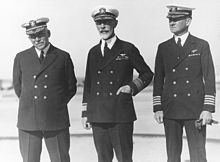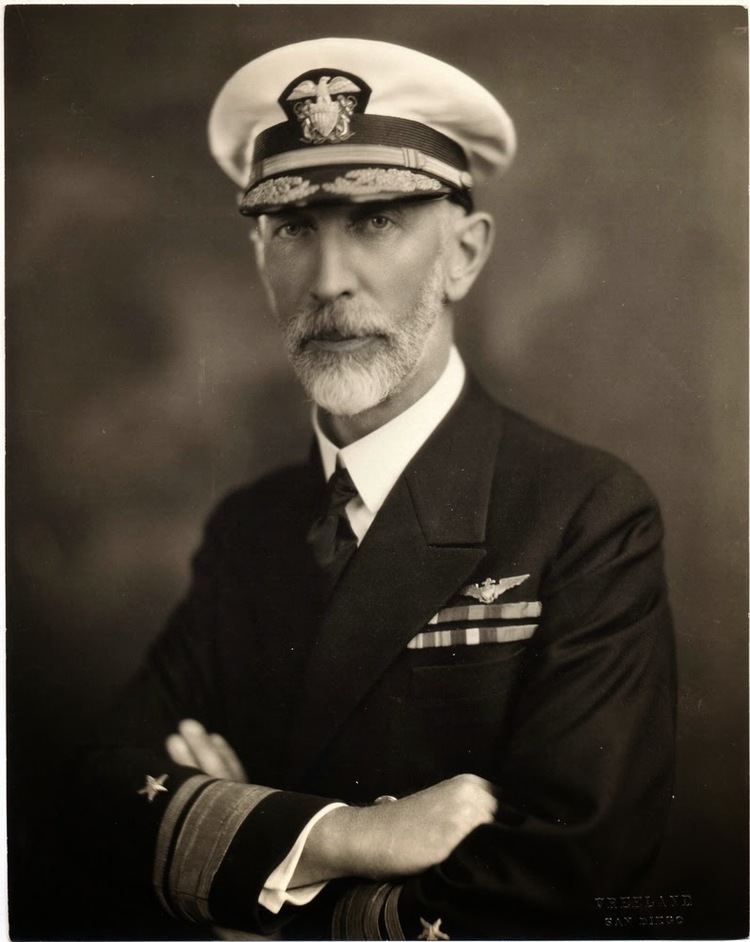Birth name Joseph Mason Reeves Nickname(s) "Bull" Name Joseph Reeves | Rank Admiral | |
 | ||
Born November 20, 1872Tampico, Illinois ( 1872-11-20 ) Allegiance United States of America Battles and wars | ||
Years of service 1894–19361940–1946 | ||
Joseph Mason "Bull" Reeves (November 20, 1872 – March 25, 1948) was an admiral in the United States Navy, who was an early and important supporter of U.S. Naval Aviation. Though a battleship officer during his early career, he became known as the "Father of Carrier Aviation" for his role in integrating aircraft carriers into the Fleet as a major part of the Navy's attack capabilities.
Contents
- Early life and career
- Start of the 20th century Through World War I
- PostWorld War I Assignments
- Entering Naval Aviation
- Recall during World War II
- Reevess legacy
- Awards and decorations
- References

Reeves retired in the mid-1930s but was recalled to active duty during World War II to serve in high-level staff positions within the Office of the Secretary of the Navy. He retired again in December 1946 with the rank of full admiral.

Early life and career
Joseph Mason Reeves was born on November 20, 1872 in the village of Tampico, Illinois.
He received an appointment in 1890 to attend the Naval Academy, where he became a football hero. In addition to his on-field heroics, he is credited with the invention of the modern football helmet, in which he had a shoemaker create for him after he was told by a Navy doctor that a kick to his head could result in "instant insanity" or death. Reeves graduated from the Academy in 1894.
Upon graduation, Reeves was assigned to the cruiser USS San Francisco (Cruiser No. 5). He served in the battleship USS Oregon (BB-3) during the Spanish–American War, taking part in the action against Admiral Pascual Cervera y Topete's fleet at Santiago in June and July 1898.
Start of the 20th century Through World War I
After the start of the 20th century, Reeves served in San Francisco and on the battleships USS Wisconsin (BB-9) and USS Ohio (BB-12) in addition to tours ashore at Newport and Annapolis, where he was an instructor in the Naval Academy's Department of Physics and Chemistry, 1906–08. He served as the Academy's Head Football Coach in 1907, guiding the team to a 9–2-1 record and a 6–0 victory over Army.
Following duties as ordnance officer on board the battleship USS New Hampshire (BB-25), Reeves served as ordnance officer in the staff of the Commander in Chief, U.S. Atlantic Fleet. He followed this with assignment to the Board of Inspection and Survey and a tour as Commanding Officer, Naval Coal Depot, Tiburon, California.
In April 1913, Commander Reeves assumed command of the collier USS Jupiter (AC-3), the Navy's first electrically propelled vessel. The ship was recommissioned in 1922 as USS Langley (CV-1), the Navy's first aircraft carrier.
Detached from Jupiter in April 1914, he commanded the cruiser USS St. Louis (Cruiser No. 20) and various other ships until assigned to Oregon, June 1915, as Commanding Officer.
Detached for shore duty at the Mare Island (California) Navy Yard, in June 1916, he commanded the battleship USS Maine (BB-10) during World War I, earning the Navy Cross for "exceptionally meritorious service" during that tour.
Post–World War I Assignments
After the war, he served as Naval Attaché at Rome and in April 1921 assumed command of USS Pittsburgh (ACR-4). Captain of the Mare Island Navy Yard at the end of that year, he commanded the battleship USS North Dakota (BB-29), 1922–23, then attended the Naval War College at Newport. After completing his coursework, he spent a year as a member of the staff.
Entering Naval Aviation
Upon completing his tour at the War College, Captain Reeves decided to enter the new world of Naval Aviation. In order to hold a command post, however, he needed to receive aviation training. Like other older officers—notably, RADM William A. Moffett, Chief of the Navy's new Bureau of Aeronautics—Reeves qualified as a "Naval Aviation Observer" rather than as a "Naval Aviator" (i.e., a pilot). He received his qualification in 1925, and assumed the post of Commander, Aircraft Squadron, Battle Fleet. Though a captain by rank, his position as squadron commander permitted him to fly a commodore's pennant. His flagship was the experimental carrier USS Langley—his old ship, Jupiter, modified for aviation operations. The wooden flight-deck was installed over the Langley's existing deck structures, giving the vessel the nickname of "Covered Wagon."
While in this command, Reeves worked hard to develop carrier aviation tactics, seeking to increase sortie rates and the use of dive-bombing. He proved these concepts by the success of his pilots and aircrew during the Navy's annual fleet exercises (known as "Fleet Problems").
Reeves served on the Navy's General Board, June 1929-June 1930. Fifteen months later he became Senior Member of the Board of Inspection and Survey, Pacific Coast Section. Another tour at Mare Island followed and in June 1933 he became Commander, Battleships, Battle Force, with the rank of vice admiral. In July, he was assigned as Commander, Battle Force, U.S. Fleet, with the rank of admiral.
On February 26, 1934, Admiral Reeves was designated Commander-in-Chief, U.S. Fleet. He held this command until June 1936, when he was ordered to Washington, D.C., to serve on the General Board. He held the Board position until November 23, 1936, and retired seven days later.
Recall during World War II
The admiral's retirement was short-lived, as his nation again needed his services to fight another World War. Reeves was recalled to active duty May 13, 1940, advanced to vice admiral on the retired list, and served in the Office of the Secretary of the Navy from May 21, 1940 until December 23, 1946. He then retired a second time, and spent his last years living in Maryland. He died at the National Naval Medical Center in Bethesda, Maryland, on March 25, 1948.
Reeves's legacy
A warship and two airfields have been named in honor of Vice Admiral Reeves.
Awards and decorations
Reeves earned the following awards and decorations:
